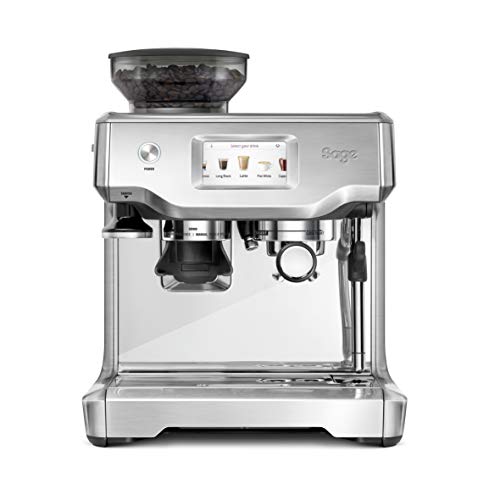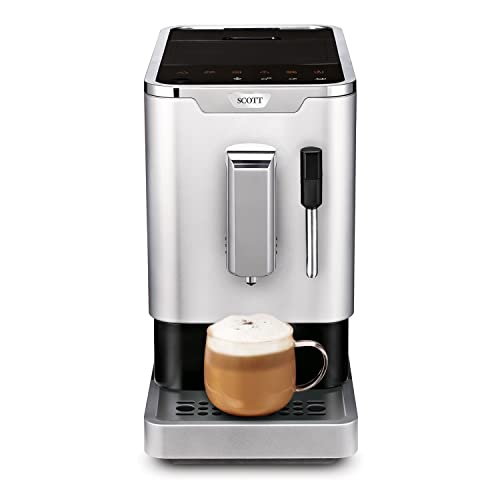자유게시판
| 제목 | What Will Coffee Machine For Beans Be Like In 100 Years? |
|---|---|
| 작성자 | Kaylee |
| 조회수 | 18회 |
| 작성일 | 24-11-08 03:03 |
| 링크 |
본문
 Bean to Cup and Semi-Automatic Coffee Machines
Bean to Cup and Semi-Automatic Coffee MachinesA bean-to-cup coffee machine grinds the beans and brews the beverage in one device. This method gives you a richer and more authentic flavor than pod-based or pre-ground coffee.
This Sage model comes with a hopper which can hold up to one pound of coffee beans. It is fully programmeable. It also performs rinse cycles prior to and following the brewing process, which prevents grounds from soaking into the milk spout and coffee pot.
Bean-to-Cup
Contrary to pod coffee machines that dispense pre-packaged and sealed cups, good bean to cup coffee machine to cup models handle the entire coffee making process from start to the end. The models have an inbuilt coffee grinder that grinds the beans before every use, making sure they are fresh and delicious. They then brew to your exact specifications. With just a few simple button presses, you'll be enjoying your coffee bean coffee machine just the way you like it!
Alongside the flexibility to create a variety of different drinks, organic bean To cup Coffee Machine-to-cup machines also let you choose your own specific coffee beans and the roast level. You can make unique drinks and experiment with new flavours that will delight your clients. You'll also save money over time since beans are cheaper than pre-packaged pods.
Another benefit of bean-to cup machines is that they're less messy than a traditional espresso machine. There is no portafilter, nor do you need pour manually. This allows you to minimise the amount of waste and mess while focusing on other things. For restaurants and bars with high staff turnover this could be a lifesaver.
Bean-to-cup machines also tend to have an additional milk hopper, which can be heated and texturised to ensure the best consistency for each type of drink. This lets you offer a wider range of drinks, and some models even have the option of making fluffy hot chocolate.
These machines that are automatic bean-to-cup are usually equipped with a menu that includes popular coffee to bean machines shop favorites. The machine does the rest. You simply choose the beverage you want. These machines are a great choice for businesses who want to make the process as easy and automated as possible.
Although they're less hands-on than traditional coffee machines however, they still require regular cleaning and descaling to avoid build-up. If you want to keep your warranty valid, you'll need utilize the descaling and cleaning solution that is recommended by the manufacturer. Luckily, this process is simple and quick and you can usually schedule reminders for these tasks to save time. It is also important to know what the terms of service and prices are for the specific model you're looking at because some models will be more expensive than others. However, it's worth it to have the peace of mind that comes with knowing your machine is in top working condition at all times.
Pod
Pod coffee machines use pre-ground beans that are sealed in capsules. These pods are a simple and convenient alternative to grinding your own coffee and measuring it out. They also eliminate any mess from dust, spills and staining.
They also provide a level of consistency that can make them popular with people who need a reliable cup every time. However, the lack of freshness is likely to produce a less tasty cup of coffee than one that a freshly-ground coffee maker would make. Furthermore, the majority of pods available are made of non-recyclable materials, and the flavors available are limited compared to the flavors offered by bean to cup coffee maker-to-cup machines.
There are many different types of pod coffee makers on the market which include K-Cup, Nespresso, Dolce Gusto, Iperespresso, Senseo and Dualit NX ESE machines. Most pod coffee machines work similarly heating the water to near boiling point, then forcing it through the capsule at a high pressure. The grounds are then removed to eliminate the necessity for messy espresso machines accessories like portafilters that are required to be free of oil.
The ease of pod machines can reduce the time needed to clean and maintain them. Most pod coffee makers only require that you regularly refill the reservoir of water.
The size of the reservoir can vary from model to model. However, they are generally small enough to be placed on your kitchen countertop. They also come with a drip tray which can accommodate both tall travel mugs as well as short espresso cups. Some models have an adjustable base that can be adjusted to the shape of your home.
Some models are designed to be hidden into a cupboard with a built-in container for empty pods that can be removed without making a mess. Others could be more permanent fixtures for your countertop, requiring you to keep an inventory of empty and full pods on hand.
The best pod machine will depend on your budget as well as preferences. If you're looking for the highest quality coffee then a bean-to- cup machine is for you. If however, convenience and user-friendliness are important to you, then a pod maker can be an excellent option. If you're not sure which one to buy, you can visit well-equipped showrooms and try the machines on in person to test their performance before making your purchase. It's also worth finding out what kinds of coffee you like and then trying out various brands to find one you're comfortable with at home. If you're fond of a particular blend you can also purchase single-estate coffees that come in pods to use in conjunction with your machine.
Semi-Automatic
Semi-automatic machines find the right balance between convenience and control. It requires some manual input but automates essential aspects of the brewing process. For instance, you'll still need to grind the beans and connect the portafilter, but the machine will be in charge of delivering pressurised water through the grounds. This type of coffee machine is usually preferred by those who love the artistry and hands-on experience of espresso making. You can also alter important brewing parameters, such as the grind size and temperature to create the perfect espresso.
This type of coffee maker is slower to operate than super-automatic or fully-automatic models. You'll also need to monitor both the brew-boiler and steam tool to ensure uniformity. As a result, it's not the best choice for large-scale coffee shops, and isn't the ideal choice for those who want their coffee to go.
If you're not looking to compromise on quality and are willing to spend more, consider a bean-to-cup coffee maker that eliminates the guesswork of brewing your espresso. This model makes use of whole beans to create an even coffee that doesn't compromise flavor or aroma. It also comes with an integrated grinder and comes with various settings that can be programmed for the most customized experience.
 Another option is a piston-style coffee machine that's similar to traditional manual lever machines. Instead of pulling down a lever, you'll press a button to activate the pump. This kind of machine allows you to determine the amount of pressure used for extraction, giving you complete control over the shot. This lets you experiment and create your own personal style. You can also make use of a separate steam wand and milk pitcher to make cappuccinos or lattes. This machine will not generate enough steam to make hot chocolate or any other non-espresso drink. This isn't to say that piston machines can't make top-quality drinks, but it's important to be aware of what you're getting into before buying one.
Another option is a piston-style coffee machine that's similar to traditional manual lever machines. Instead of pulling down a lever, you'll press a button to activate the pump. This kind of machine allows you to determine the amount of pressure used for extraction, giving you complete control over the shot. This lets you experiment and create your own personal style. You can also make use of a separate steam wand and milk pitcher to make cappuccinos or lattes. This machine will not generate enough steam to make hot chocolate or any other non-espresso drink. This isn't to say that piston machines can't make top-quality drinks, but it's important to be aware of what you're getting into before buying one.



